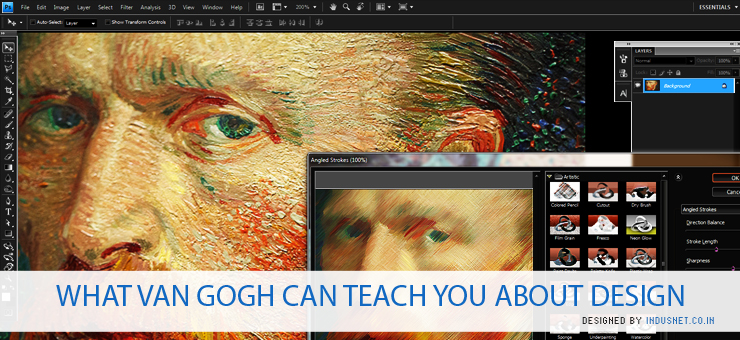
Vincent Van Gogh is probably one of the most famous post-impressionists in the world. Though he died almost 125 years ago, his work continues to inspire people till date. His life was full of difficulties but his art persists and the way he led his life, probably, shaped his style of art as well.
Van Gogh was known for paintings that were rough in their beauty, bold and emotionally honest. His art had a far reaching influence on the 20th Century art and surprisingly, on design as well. When we talk about design, we cannot be very distant from web designing.
The way he used colors, light techniques and the way he created images on the canvas can all be sources of inspiration for modern web designers. Moreover, his life itself has a lot to teach us and inspire. Though he led a very difficult and tragically short life, his style of working continues to inspire and challenge us when we encounter difficulties ourselves.
Van Gogh was an enigma who produced more than 2,100 artworks. He painted self-portraits, landscapes, portraits and a whole lot of other things that are closely related to the school of impressionism. In this article, let us take a look at what his work and life can teach us about design and web design in particular.
Choice of colors and light
Van Gogh was a proponent of impressionism. Impressionism was a school of art that questioned the need for specific lines and outlines in paintings. The paintings were not mere replicas of what were seen but, instead, used color and light to create “movements” within paintings.
Thus, the slightly distorted images within a painting came to represent how our identities are continuous and that they overlap with other people’s or our environment’s outlines as well. Impressionism was not very popular in the late 19th Century and received considerable criticism. However, towards the end of Van Gogh’s life, his style became very popular.
Web designers can pay attention to how lights and colors can create a sort of movement within images. With the help of modern software programs, we can easily create logos and websites that are a reflection of impression. If not blatantly impressionist, we can at least create logos and websites that are inspired by impressionism.
Facing challenges in life
Van Gogh’s life was not easy. He suffered from a number of physical and psychological issues. He even cut off a part of his ear and gave it away to a streetwalker; and in the midst of all these challenging and troublesome issues, he persisted and created some of the most magnificent pieces of artwork ever created.
He took his difficulties as a challenge and continued to create works of art that were unparalleled. If you are a web designer and are looking to create something phenomenal, you can choose to read about Van Gogh and his life. His life will surely inspire anybody who is into design and art.
Thinking out of the box
Van Gogh was not someone who stuck to traditional ideas. He was as unconventional as artists can possibly get. This nature of thinking out of the box helped him to create paintings that were met with stiff criticism initially but later on, were recognized as masterpieces. If you are a web designer and create something challenging, expect to be criticized.
However, if you really have talent, you will sooner or later be appreciated for your uniqueness and unconventionality. Unconventionality and uniqueness are always important while creating design, whether virtual or real. If you create logos or websites, you will know how important it is to create designs that are unique.
Learning from other’s life stories
The example of Van Gogh needs to be taken as a lesson to learn from the life stories of stalwarts. Famous artists and designers always had challenging life issues and they persisted with their talent. If you want to make your mark and leave a legacy behind, you need to be as inspired as they used to be. Take all your problems as challenges and create phenomenal designs that will last for a long time. That needs to be the lesson to learn from Van Gogh’s life history.